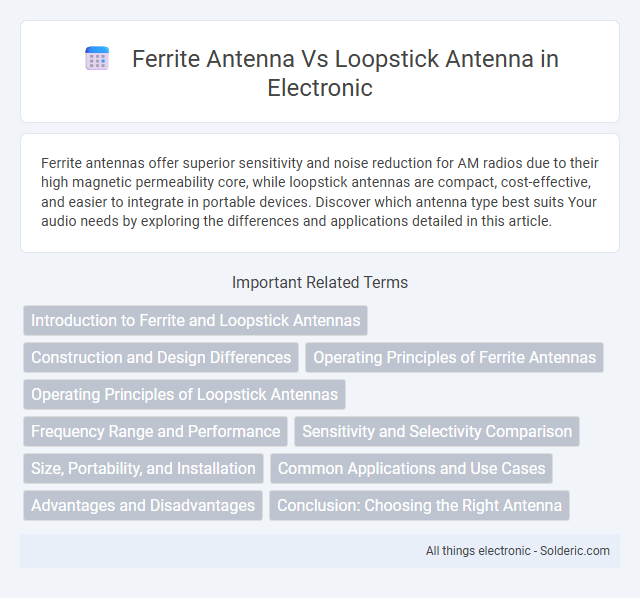Ferrite antennas offer superior sensitivity and noise reduction for AM radios due to their high magnetic permeability core, while loopstick antennas are compact, cost-effective, and easier to integrate in portable devices. Discover which antenna type best suits Your audio needs by exploring the differences and applications detailed in this article.
Comparison Table
| Feature | Ferrite Antenna | Loopstick Antenna |
|---|---|---|
| Core Material | Ferrite rod | Ferrite rod (smaller size) |
| Size | Larger, typically 6-10 cm | Smaller, typically 2-4 cm |
| Frequency Range | Medium wave (AM) band | Medium wave (AM) band, sometimes extended |
| Inductance | Higher inductance due to larger coil turns | Lower inductance, fewer coil turns |
| Sensitivity | Higher sensitivity for AM reception | Moderate sensitivity, suitable for portable devices |
| Usage | Standard AM radios, high-quality receivers | Portable AM radios, compact devices |
| Signal Directionality | Directional, useful for tuning | Less directional, compact design focus |
Introduction to Ferrite and Loopstick Antennas
Ferrite antennas utilize a ferrite core wrapped with wire to boost magnetic field reception, making them highly effective for AM radio frequencies. Loopstick antennas are essentially compact ferrite rod antennas designed as a coil wound around a magnetic rod, allowing for improved signal strength and noise reduction in portable receivers. Your choice between ferrite and loopstick antennas depends on factors like size constraints and desired signal clarity in specific radio applications.
Construction and Design Differences
Ferrite antennas are constructed using a ferrite rod core wrapped with multiple turns of wire, enhancing magnetic flux concentration and signal reception, while loopstick antennas typically feature a smaller ferrite core with a coiled wire loop that emphasizes compactness and directional sensitivity. The ferrite antenna's design prioritizes high inductance and noise reduction, making it ideal for AM radio applications, whereas loopstick antennas focus on portability and ease of integration into smaller devices. Understanding these construction and design differences helps you select the optimal antenna for your specific radio frequency needs.
Operating Principles of Ferrite Antennas
Ferrite antennas operate based on the magnetic properties of ferrite cores, which concentrate and enhance magnetic flux from radio signals, increasing inductance and sensitivity to electromagnetic waves. These cores are wrapped with coils of wire that convert magnetic flux variations into electrical signals, allowing efficient reception in AM radios. The compact size and high permeability of ferrite materials enable better signal amplification compared to traditional air-core loopstick antennas.
Operating Principles of Loopstick Antennas
Loopstick antennas operate by using a ferrite core wrapped with a coil of wire to create a compact, high-inductance inductor that effectively captures magnetic components of radio signals. Their operating principle relies on the magnetic field interaction with the coil, allowing efficient reception in AM broadcast bands, especially in portable radios. Your device benefits from enhanced signal sensitivity and selectivity due to the ferrite core's ability to concentrate magnetic flux within the loopstick antenna.
Frequency Range and Performance
Ferrite antennas typically operate effectively within the low to medium frequency range, around 100 kHz to 3 MHz, demonstrating high sensitivity and selectivity for AM radio signals. Loopstick antennas, a specific type of ferrite antenna, excel in compact designs for portable receivers but may have limited frequency range and reduced efficiency at higher frequencies above 2 MHz. Performance-wise, ferrite antennas provide better signal reception due to their larger core size and higher permeability, whereas loopstick antennas prioritize size and portability, often sacrificing some sensitivity and bandwidth.
Sensitivity and Selectivity Comparison
Ferrite antennas generally offer higher sensitivity due to their larger magnetic core, which effectively concentrates magnetic flux and enhances signal reception, especially in lower frequency bands. Loopstick antennas, with their smaller size and simpler construction, tend to have lower sensitivity but can sometimes provide better selectivity in crowded signal environments due to reduced noise pickup. Optimizing Your radio's antenna choice depends on balancing the need for strong signal strength with the ability to discriminate between closely spaced channels.
Size, Portability, and Installation
Ferrite antennas are typically compact and enclosed, making them highly portable and simple to install in tight spaces, ideal for portable radios and compact receivers. Loopstick antennas, consisting of a coil wound around a ferrite rod, offer a slightly larger size but still maintain good portability, often requiring minimal installation efforts such as mounting within a device chassis. Your choice between ferrite and loopstick antennas should consider the balance between size constraints and ease of integration dependent on the specific application.
Common Applications and Use Cases
Ferrite antennas are widely used in AM radios, portable receivers, and shortwave communication devices due to their compact size and effective magnetic field reception. Loopstick antennas, a type of ferrite antenna with a coil wound around a ferrite rod, are commonly employed in handheld radios and emergency broadcast receivers for their sensitivity to weak signals. Both antenna types excel in low-frequency bands, making them ideal for medium-wave and long-wave tuning applications.
Advantages and Disadvantages
Ferrite antennas offer high sensitivity and excellent noise rejection, making them ideal for AM radio applications in compact devices, while loopstick antennas provide a smaller, simpler design with lower cost but reduced sensitivity. Ferrite antennas' magnetic core concentrates the signal, enhancing reception quality, whereas loopstick antennas may suffer from weaker signal capture in noisy environments. Your choice depends on whether priority is placed on signal clarity and strength or on size and budget constraints.
Conclusion: Choosing the Right Antenna
Choosing the right antenna depends on your specific application and signal requirements. Ferrite antennas offer excellent sensitivity for AM radio reception in compact devices, while loopstick antennas provide a simpler, cost-effective solution with decent performance in low-interference environments. Assess your device's design constraints and desired signal quality to determine which antenna best suits Your needs.
ferrite antenna vs loopstick antenna Infographic

 solderic.com
solderic.com